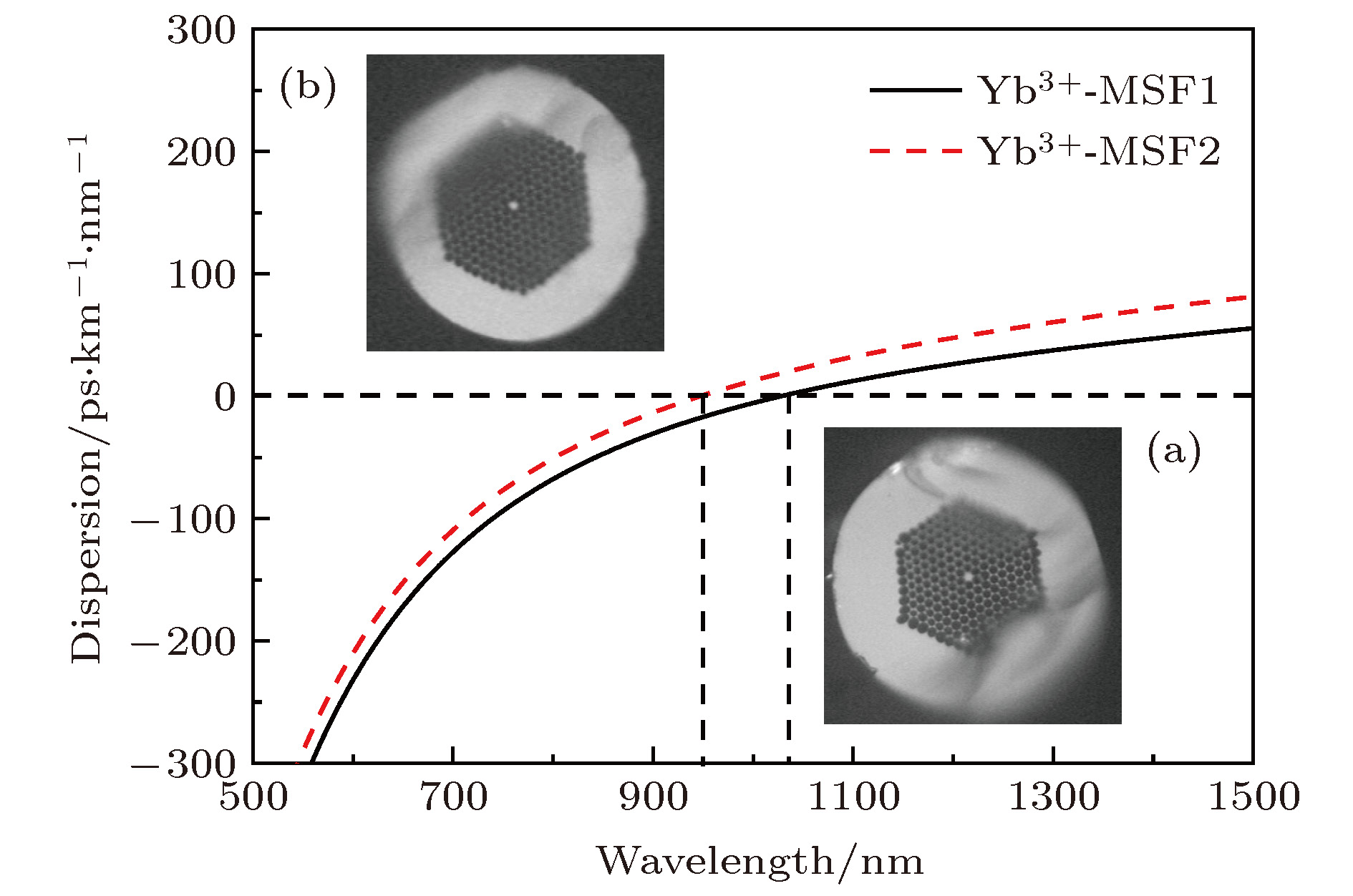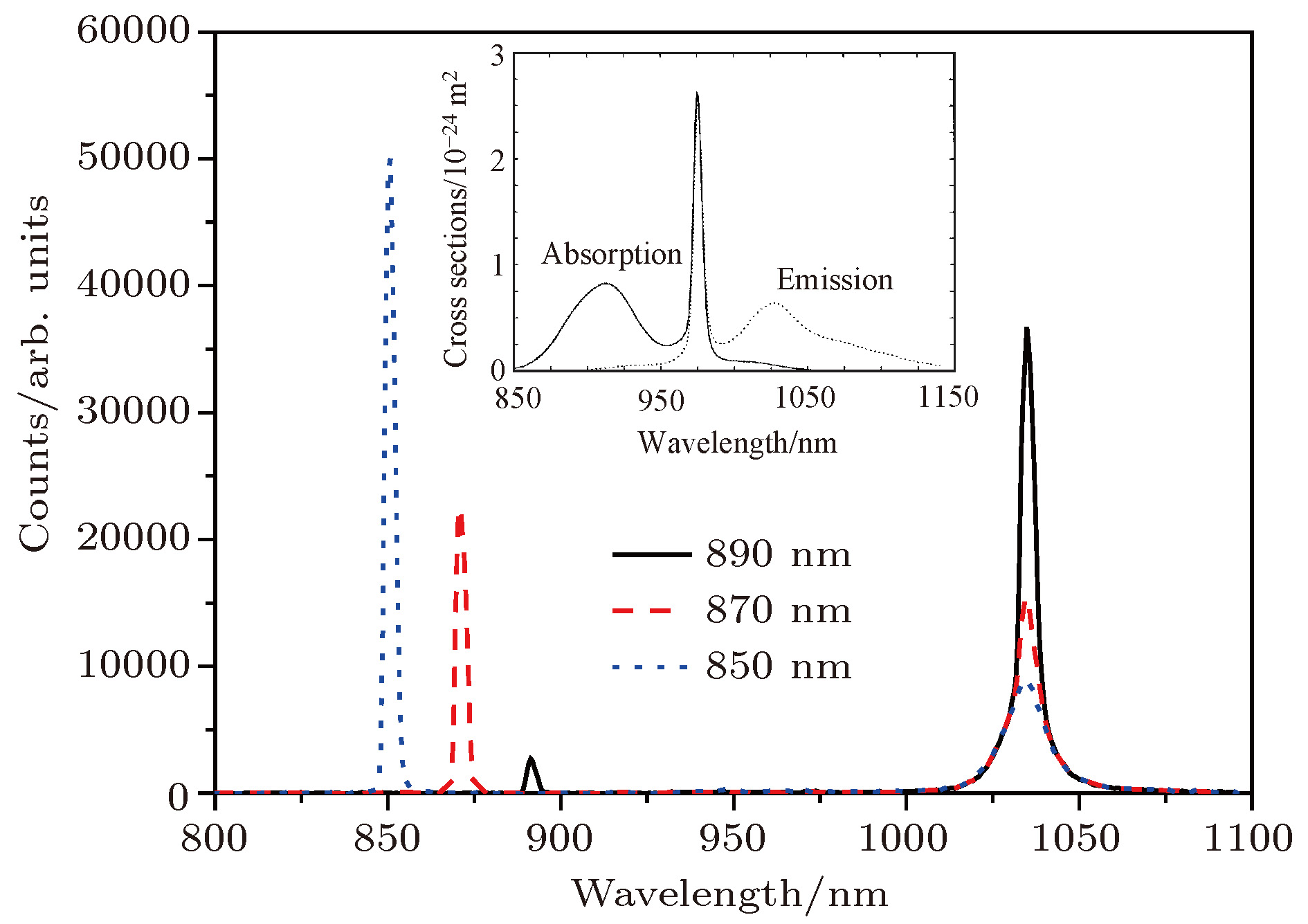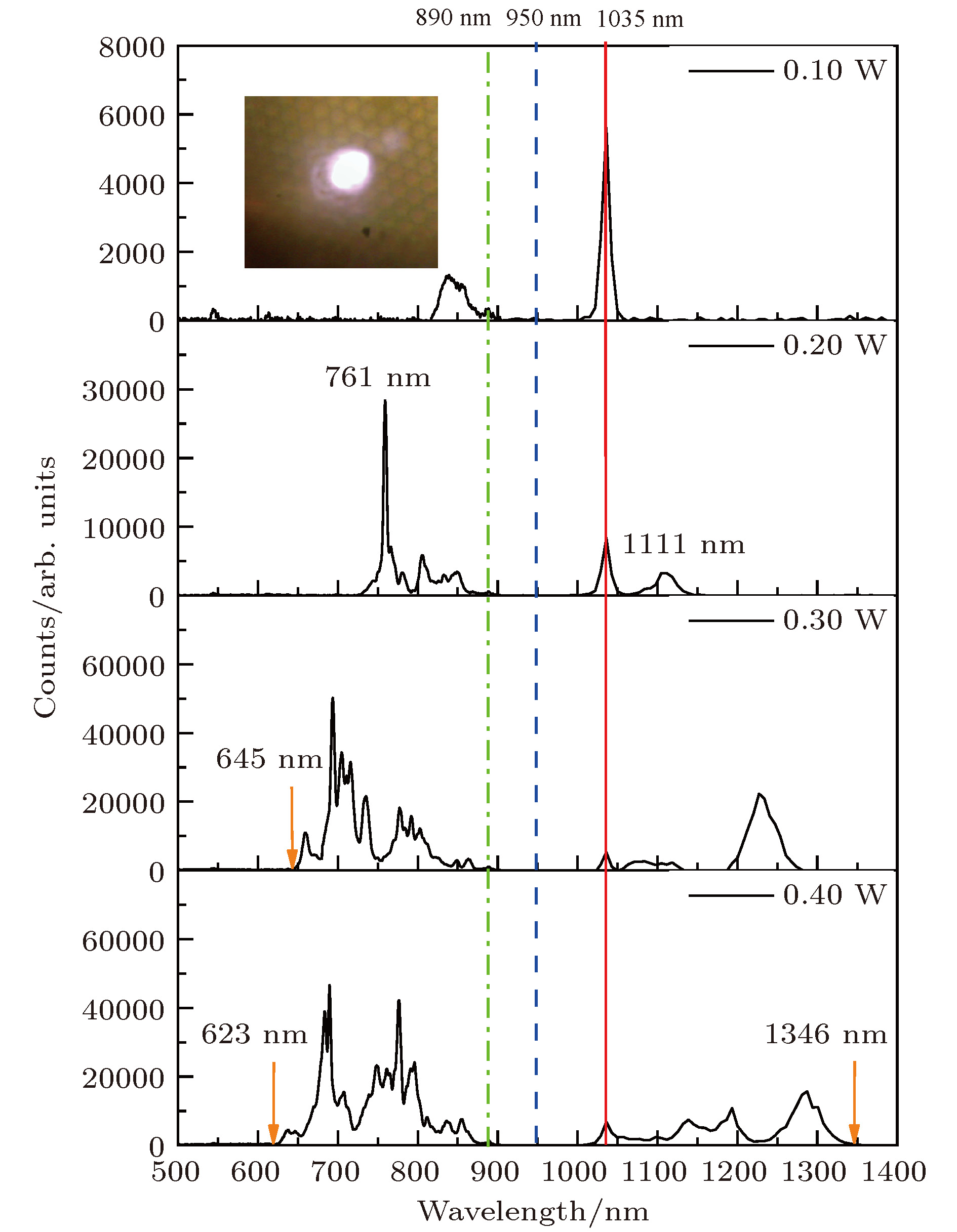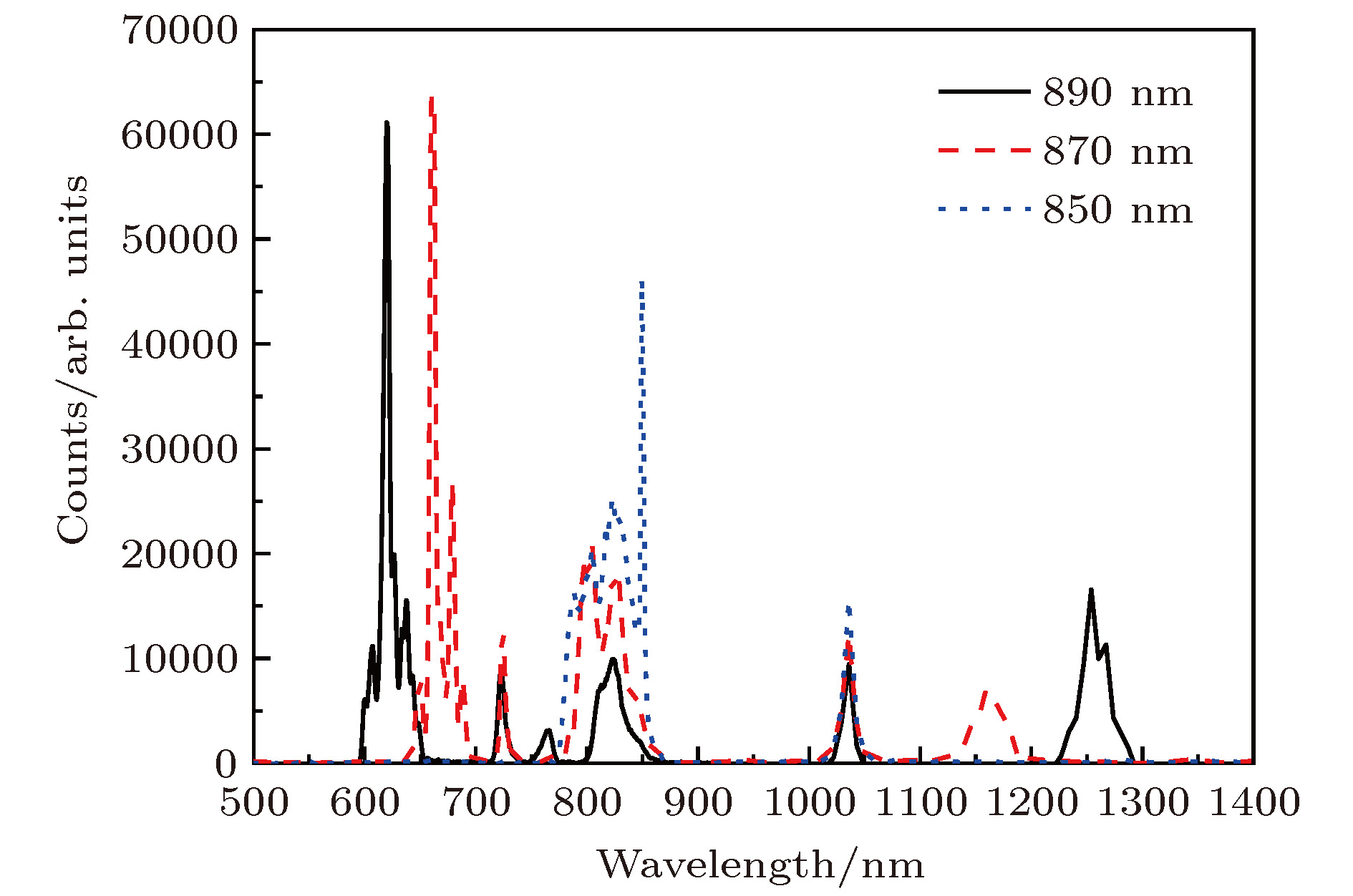-
本文利用钛蓝宝石飞秒激光器抽运自制的掺镱微结构光纤, 对微结构光纤中的非线性效应及超连续谱产生机理进行了实验研究. 研究发现, 当抽运光偏离Yb3+吸收最高峰85 nm时, 仍具有较高的发光效率. 在飞秒脉冲抽运下, 位于反常色散区的发射光首先被位于正常色散区的抽运光激发、放大并俘获, 然后演化为超短脉冲, 随后在微结构光纤中产生非线性效应. 微结构光纤1发射光位于零色散波长附近, 产生基阶孤子并在拉曼作用下红移, 微结构光纤2发射光位于距离零色散波长较远的反常色散区, 产生高阶孤子分裂效应形成超连续谱, 但是1380 nm处的OH-吸收限制了超连续谱的进一步展宽. 忽略抽运光耦合效率、微结构光纤损耗等因素的影响, 输出光谱中超连续谱的产生效率最高可以达到98%以上, 意味着几乎所有的残余抽运光和发射光均展宽为超连续谱. 在0.50 m长的微结构光纤中, 获得了较高的波长转换效率和较宽的超连续谱. 通过拉锥处理, 零色散波长发生蓝移, 最终产生的超连续谱相在短波处范围展宽, 而在长波处范围缩短. 因此利用钛蓝宝石飞秒激光器抽运Yb3+掺杂微结构光纤, 可以获得可调谐的超连续谱.The nonlinear effects and supercontinuum generation by the concept of wavelength conversion and amplification are experimentally studied in two Yb3+-doped microstructure fibers (Yb3+-MSFs), with the Ti: sapphire femtosecond pulses used as pump. Firstly, two Yb3+-MSFs are pumped by continuous wave separately to obtain the emission spectrum. The relationship between the luminous efficiency and the deviation of pump light from the Yb3+ absorption peak is studied for each of the two fibers. The experimental results indicate that the luminous efficiency decreases as the deviation increases. However, both fibers still have high luminous efficiency even when the deviation reaches to 85 nm. Secondly, the supercontinuum spectrum is generated by the femtosecond laser pumping the cores of the two fibers. The influence of the pump power, relative position between emission light and zero-dispersion wavelength λ0, pump wavelength and fiber length on the supercontinuum generation are studied. The results demonstrate that the amplified emission light at 1035 nm is first captured by the pump light to evolve into ultrashort pulse, and nonlinear effects are subsequently generated. As the pump power increases, for Yb3+-MSF1 whose λ0 is located near the emission light of Yb3+ irons, the fundamental soliton is generated and further shifts toward red region under Raman effect. Compared with Yb3+-MSF1, the Yb3+-MSF2 has a small core, which means that its λ0 is short and the emission light is located in its anomalous dispersion region far from the λ0. Experimental results reveal that higher-order soliton and soliton fission are more likely to happen and supercontinuum spectrum can be formed. However, the further broadening of the supercontinuum spectrum is limited by OH- absorption at 1380 nm. Either increasing the deviation of pump light from the Yb3+ absorption peak or shortening the fiber length reduces the accumulated power of the emission light, so the experimental results show that red-shift of Raman soliton is reduced and the supercontinuum spectrum is narrowed for both fibers. The supercontinuum generation efficiency in the output spectrum can reach 98% when the effect of pump light coupling efficiency and microstructure fiber loss are neglected. It means that almost all the residual pump light and emission light of Yb3+ contribute to the generation of supercontinuum. Finally, the Yb3+-MSF2s are tapered to different taper lengths to study their influence on supercontinuum generation. The results indicate that the leakage after tapering weakens the energy of the Raman soliton, which further results in the decrease of red-shift. Eventually, the red edge of supercontinuum spectrum shrinks seriously with theincrease of the taper length. However, the decreasing of λ0 at the taper waist leads to blue-shift of dispersive wave that satisfies the phase matching condition with Raman soliton. This contributes to the blue-shift of the short wavelength boundary and widens the range of supercontinuum spectrum at short wavelength. Therefore, tapering is a promising method of expanding supercontinuum spectrum towards short wavelength. In conclusion, the supercontinuum spectrum is generated in Yb3+-doped microstructure fiber pumped by the Ti: sapphire femtosecond laser. The output spectrum can be adjusted flexibly by combining the merit of high peak power and wavelength tunability of Ti: sapphire femtosecond laser and the characteristics of wavelength conversion and amplification of Yb3+ irons. Thus, the method presented in the paper provides a promising way to obtain tunable supercontinuum spectrum.
[1] Alfano R R, Shapiro S L 1970 Phys. Rev. Lett. 24 584
 Google Scholar
Google Scholar
[2] Ranka J K, Windeler R S, Stentz A J 2000 Opt. Lett. 25 25
 Google Scholar
Google Scholar
[3] Hartl I, Li X D, Chudoba C, Ghanta R K, Ko T H, Fujimoto J G, Ranka J K, Windeler R S 2001 Opt. Lett. 26 608
 Google Scholar
Google Scholar
[4] 胡明列, 王清月, 栗岩峰, 王专, 张志刚, 柴路, 章若冰 2004 53 4243
 Google Scholar
Google Scholar
Hu M L, Wang Q Y, Li Y F, Wang Z, Zhang Z G, Chai L, Zhang R B 2004 Acta Phys. Sin. 53 4243
 Google Scholar
Google Scholar
[5] Konorov S, Zheltikov A 2003 Opt. Express 11 2440
 Google Scholar
Google Scholar
[6] Wang Z X, Liu J S, Li R X, Xu Z Z 2009 Opt. Express 17 13841
 Google Scholar
Google Scholar
[7] Moeser J T, Wolchover N A, Knight J C, Omenetto F G 2007 Opt. Lett. 32 952
 Google Scholar
Google Scholar
[8] 孟飞, 曹士英, 蔡岳, 王贵重, 曹建平, 李天初, 方占军 2011 60 125
 Google Scholar
Google Scholar
Meng F, Cao S Y, Cai Y, Wang G Z, Cao J P, Li T C, Fang Z J 2011 Acta Phys. Sin. 60 125
 Google Scholar
Google Scholar
[9] 陈泳竹, 徐文成, 崔虎 2003 光学学报 23 000297
Chen Y Z, Xu W C, Cui H 2003 Acta Opt. Sin. 23 000297
[10] 李曙光, 程同蕾, 张焕平, 侯蓝田 2008 中国激光 35 1041
 Google Scholar
Google Scholar
Li S G, Cheng T L, Zhang H P, Hou L T 2008 Chinese J. Lasers 35 1041
 Google Scholar
Google Scholar
[11] Alexander M H, Alexander H, Gurthwin W B, Patrizia K, Erich G R, Heinrich S, Hartmut B 2011 Opt. Express 19 3775
 Google Scholar
Google Scholar
[12] Jinendra K R, Robert S W, Andrew J S 2000 Opt. Letters 25 796
 Google Scholar
Google Scholar
[13] Han Y, Hou L T, Zhou G Y, Yuan J H, Xia C M, Wang W, Wang C, Hou Z Y 2012 Chin. Phys. Lett. 29 54208
 Google Scholar
Google Scholar
[14] Minkovich V P, Pereira M V, Villatoro J, Evgeny M, Alexander B S, Ivan S D, María A I, Joseba Z 2016 J. Lightwave Technol. 34 4387
 Google Scholar
Google Scholar
[15] Roy A, Auguste J L, Leproux P, Auguste J L, Couderc V 2007 J. Opt. Soc. Am. B 24 788
 Google Scholar
Google Scholar
[16] Louot C, Shalaby B M, Capitaine E, Hilaire S, Leproux P, Pagnoux D, Couderc V 2016 IEEE Photonic. Tech. L. 28 2011
 Google Scholar
Google Scholar
[17] Baselt T, Taudt C, Nelsen B, Lasagni A F, Hartmann P 2016 Nonlinear Frequency Generation and Conversion: Materials, Devices, and Applications XV San Francisco, California, United States, February 13—18, 2016 97310L
[18] Baselt T, Taudt C, Nelsen B, Lasagni A F, Hartmann P 2017 Nonlinear Frequency Generation and Conversion: Materials and Devices XVI San Francisco, California, United States, January 28— February 2, 2017 100880E
[19] Wang W, Meng F C, Qing Y, Qiu S, Dong T T, Zhu W Z, Zuo Y T, Han Y, Wang C, Qi Y F, Hou L T 2018 Chin. Phys. Lett. 35 104202
 Google Scholar
Google Scholar
[20] Paschotta R, Nilsson J, Tropper A C, Hanna D C 2001 IEEE J. Quantum Elect. 33 1049
[21] Leon-Saval S G, Birks T A, Wadsworth W J, Russell P St J 2004 Opt. Express 12 2864
 Google Scholar
Google Scholar
-
-
[1] Alfano R R, Shapiro S L 1970 Phys. Rev. Lett. 24 584
 Google Scholar
Google Scholar
[2] Ranka J K, Windeler R S, Stentz A J 2000 Opt. Lett. 25 25
 Google Scholar
Google Scholar
[3] Hartl I, Li X D, Chudoba C, Ghanta R K, Ko T H, Fujimoto J G, Ranka J K, Windeler R S 2001 Opt. Lett. 26 608
 Google Scholar
Google Scholar
[4] 胡明列, 王清月, 栗岩峰, 王专, 张志刚, 柴路, 章若冰 2004 53 4243
 Google Scholar
Google Scholar
Hu M L, Wang Q Y, Li Y F, Wang Z, Zhang Z G, Chai L, Zhang R B 2004 Acta Phys. Sin. 53 4243
 Google Scholar
Google Scholar
[5] Konorov S, Zheltikov A 2003 Opt. Express 11 2440
 Google Scholar
Google Scholar
[6] Wang Z X, Liu J S, Li R X, Xu Z Z 2009 Opt. Express 17 13841
 Google Scholar
Google Scholar
[7] Moeser J T, Wolchover N A, Knight J C, Omenetto F G 2007 Opt. Lett. 32 952
 Google Scholar
Google Scholar
[8] 孟飞, 曹士英, 蔡岳, 王贵重, 曹建平, 李天初, 方占军 2011 60 125
 Google Scholar
Google Scholar
Meng F, Cao S Y, Cai Y, Wang G Z, Cao J P, Li T C, Fang Z J 2011 Acta Phys. Sin. 60 125
 Google Scholar
Google Scholar
[9] 陈泳竹, 徐文成, 崔虎 2003 光学学报 23 000297
Chen Y Z, Xu W C, Cui H 2003 Acta Opt. Sin. 23 000297
[10] 李曙光, 程同蕾, 张焕平, 侯蓝田 2008 中国激光 35 1041
 Google Scholar
Google Scholar
Li S G, Cheng T L, Zhang H P, Hou L T 2008 Chinese J. Lasers 35 1041
 Google Scholar
Google Scholar
[11] Alexander M H, Alexander H, Gurthwin W B, Patrizia K, Erich G R, Heinrich S, Hartmut B 2011 Opt. Express 19 3775
 Google Scholar
Google Scholar
[12] Jinendra K R, Robert S W, Andrew J S 2000 Opt. Letters 25 796
 Google Scholar
Google Scholar
[13] Han Y, Hou L T, Zhou G Y, Yuan J H, Xia C M, Wang W, Wang C, Hou Z Y 2012 Chin. Phys. Lett. 29 54208
 Google Scholar
Google Scholar
[14] Minkovich V P, Pereira M V, Villatoro J, Evgeny M, Alexander B S, Ivan S D, María A I, Joseba Z 2016 J. Lightwave Technol. 34 4387
 Google Scholar
Google Scholar
[15] Roy A, Auguste J L, Leproux P, Auguste J L, Couderc V 2007 J. Opt. Soc. Am. B 24 788
 Google Scholar
Google Scholar
[16] Louot C, Shalaby B M, Capitaine E, Hilaire S, Leproux P, Pagnoux D, Couderc V 2016 IEEE Photonic. Tech. L. 28 2011
 Google Scholar
Google Scholar
[17] Baselt T, Taudt C, Nelsen B, Lasagni A F, Hartmann P 2016 Nonlinear Frequency Generation and Conversion: Materials, Devices, and Applications XV San Francisco, California, United States, February 13—18, 2016 97310L
[18] Baselt T, Taudt C, Nelsen B, Lasagni A F, Hartmann P 2017 Nonlinear Frequency Generation and Conversion: Materials and Devices XVI San Francisco, California, United States, January 28— February 2, 2017 100880E
[19] Wang W, Meng F C, Qing Y, Qiu S, Dong T T, Zhu W Z, Zuo Y T, Han Y, Wang C, Qi Y F, Hou L T 2018 Chin. Phys. Lett. 35 104202
 Google Scholar
Google Scholar
[20] Paschotta R, Nilsson J, Tropper A C, Hanna D C 2001 IEEE J. Quantum Elect. 33 1049
[21] Leon-Saval S G, Birks T A, Wadsworth W J, Russell P St J 2004 Opt. Express 12 2864
 Google Scholar
Google Scholar
计量
- 文章访问数: 12867
- PDF下载量: 69
- 被引次数: 0














 下载:
下载:










